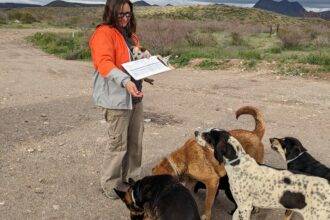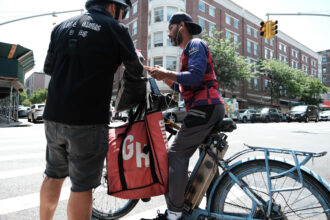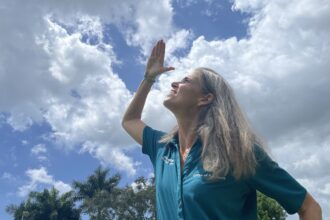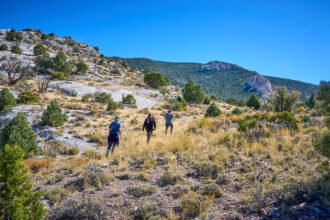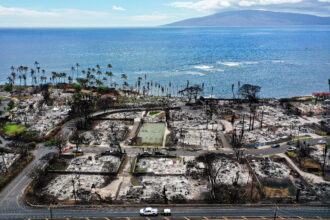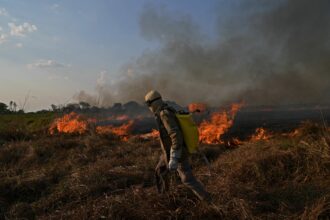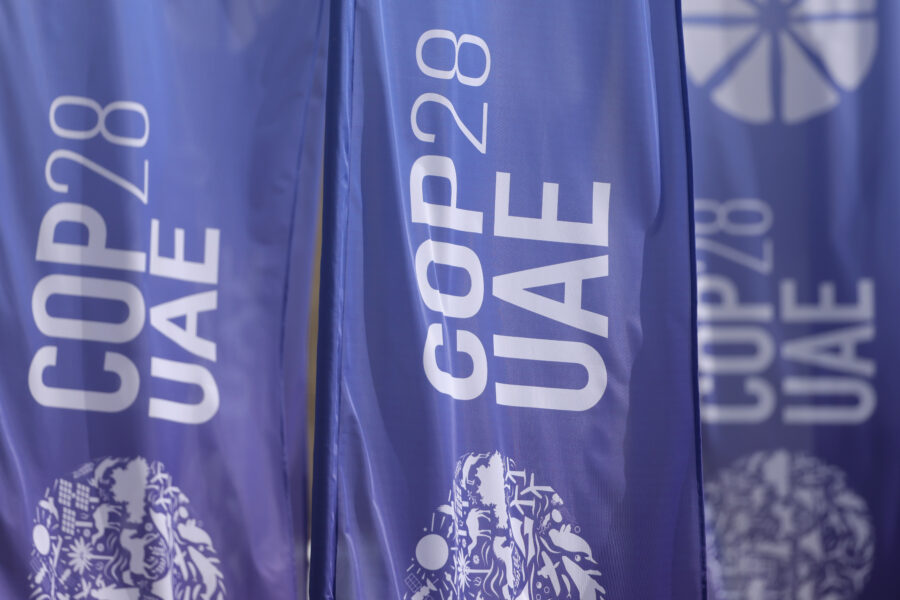The Phoenix summer of 2023 was one for the record books.
For 54 days straight—36 more than the previous record—the hottest city in the country had high temperatures of 110 degrees Fahrenheit or higher. That heat led to nearly 300 confirmed deaths so far, with more under investigation by the county, mostly among the unhoused population.
Local electricity providers reported the highest-ever demand for power as the city’s residents cranked up their air conditioning. And while the city baked, Arizona Gov. Katie Hobbs announced that the Phoenix metropolitan area was tapped out of groundwater while the Southwestern state continues to negotiate with its neighbors over future cuts to their supplies from the Colorado River.
In a summer with no shortage of climate-caused disasters and extreme weather events, Phoenix yet again showed the perils that climate change poses to the nation’s biggest cities, particularly those in the dry, hot west.
The city’s mayor, Kate Gallego, now in her fifth year in office, believes Phoenix can pave a path forward as a model of how to build a sustainable community in the face of climate change. “We understand how to live in a hot environment and we’ve got a lot of solutions,” she told Inside Climate News in Phoenix after returning from New York City, where she spoke at Climate Week NYC.
Those solutions include a heat-mitigation office with the long-term priorities of planting more shade trees throughout the city, establishing a cool pavement program that replaces black asphalt with lighter-colored surfaces, and, in making policy that considers how heat impacts nearly every facet of Phoenix.
But change takes time, money and buy-in from the community. In an interview with Inside Climate News, Gallego outlined the steps needed to make Phoenix more sustainable, how the city is looking to address drought and extreme heat and how communities can work together to deal with climate change.
The interview has been edited for clarity and length.
You were in New York last month for climate week to talk about the work Phoenix is doing on its quest to become the most sustainable desert city in the world. How can Phoenix earn that title?
It comes from our general plan, which our voters asked for about a decade ago, setting an ambitious agenda for us. Part of the way to get there is to understand what other communities are doing and adopt the best ideas, as well as share our ideas so that other communities know what’s working for us and maybe can help us refine and improve programs. We want to be on the cutting edge of everything from nature-based solutions to advanced technology.
At Climate Week, I had the chance to meet up with startups that are helping people manage their water use, as well as how to plant trees most effectively to help people with their energy bills and outdoor commutes.
The city created the Office of Heat Response and Mitigation in 2021, the first of its kind in the country, which has helped Phoenix respond to extreme heat during the summer and also work to mitigate it. What have you learned so far from the program and how do you keep building on it?
The office of heat has shown us that as a city, we need to keep heat in mind in every part of our community, we ought to think about heat as we design the city. The office of heat has been wonderful in that it fixes a governance gap. We now know who is in charge of that particular issue and people with great ideas can move forward.
When I was first elected, we were very aggressive about protecting the public right of way and saying “you can’t build things over the sidewalks.” We’ve now done a complete turnaround and we’re pushing people to build shade, whether it be to shade canopies or trees. So we have now the goal that we’re going to try to get 75 percent shade coverage in our most heavily trafficked areas, such as downtown.
That was something that other cities were very interested in and felt might make sense for their communities.
People were interested in the fact that we have a tree farm that tries to grow trees with deep tap roots so that they are more sustainable in our desert. It’s fairly unusual for a city to have a tree farm.
A big issue with planting more trees in the desert is just getting them to live. How is the city working to make sure that those trees can live and create the shade they are supposed to?
Two weeks ago we received a $10 million grant from the Biden administration around tree planting and they really pushed us to think long term. Where can the trees thrive and who is the workforce that will maintain them?
One of the things I’ve learned from other cities is that if you pay people in a local community to maintain the trees and help them develop the expertise needed, that can really help the trees thrive. So basic things like how you prune a tree make a big difference in how successful the tree can be.
We’re trying to improve how we design our city streets to make sure we build them so that the tree root system has the chance to grow and thrive. We’ve certainly made mistakes where we planted trees where there wasn’t really enough soil. And so we now have experts in horticulture in multiple departments from parks to streets that are helping us lead with science in these areas. It’s not enough to just plant the tree.
Heat experts and urban planners say the real answer to dealing with heat, drought concerns and pollution is reigning in urban sprawl and building denser communities instead of single-family homes. Is that an issue the city is looking to address?
We’ve made investments like our transportation 2050 plan that will triple the light rail system, which will really help us have the capability to build a denser Phoenix.
We are now seeing about a 30 percent decline in single-family permits and about a 30 percent increase in multifamily permits. So much of the growth we’re seeing now tends to be along transportation corridors and taller, more urban building forms.
Part of that has been driven by the great amenities along our transportation corridors and part of that has been steps we’ve taken like our walkable urban code to really try to bring people into our amazing downtown.
The city recently delayed a vote on reducing the minimum parking spot requirements at apartments, which experts have said is one way to deal with the urban heat island effect, following community pushback claiming that the change would disproportionately impact low-income residents and their commutes to work. In a car-centric city like Phoenix, how do you address those concerns and get residents to buy into these proposals?
People have been voting with their feet. We’ve seen a dramatic increase in the amount of housing in our downtown as well as along the light rail corridor. We really are seeing people who will move here and say “I don’t want to have a car” which is not something you have traditionally seen. I’m confident that the city will move forward with parking reductions, but we had some equity issues that we needed to work through at the committee level.
You mentioned voting with your feet and, obviously, that’s doable for people who have the money to do so, but places like downtown Phoenix are fairly expensive to live in. How do you make sure those types of places are developed but remain affordable?
Our city actually has a pretty high percentage of multifamily housing that is either completely affordable or has an affordable component. The city moves forward with a policy around property tax incentives that said affordable housing is a top priority.
There was actually a time when we were pretty heavily criticized for having too many affordable housing developments in our downtown but we’re really, I think, focused most on mixed-income. So really diverse communities can be enormously successful and we want all different types of housing.
Keep Environmental Journalism Alive
ICN provides award-winning climate coverage free of charge and advertising. We rely on donations from readers like you to keep going.
Donate NowWe’re going to our voters with a bond election this November that has a significant affordable housing component. The bond also has money for green stormwater infrastructure and electric vehicles, a lot of good heat resilience programs as well.
Phoenix is facing a lot of scrutiny over its water supply, from restrictions on groundwater to likely cutbacks on Colorado River water in the future. How is the city looking to shore up its water supply?
Ninety-eight percent of our water supply comes from surface water. We’ve worked hard to develop a robust and diverse water portfolio with multiple sources and contingency supplies, including partnerships ranging from other cities to tribal nations. We’re investing in using our water efficiently.
My big focus at my State of the City this year was a water recycling plant—a billion-dollar investment that we hope will deliver 60 million gallons of recycled water per day. We are regularly launching new water conservation programs. This month, we had one around turf removal for ornamental grasses, we want to … partner with HOAs and businesses to remove it. We launched a leak detection program which has a very cool app that will help building managers detect leaks.
We launched it at one of our public housing homes for older adults. There’s a single meter on the hundreds of apartments, and so even if you detect a leak, it is really hard to figure out which appliance is leaking. So putting these sensors in every unit helps us get the leaks right away and we helped save a significant amount of water in that area. We are now consulting for HOAs, businesses and homeowners to help people manage their water.
Outdoor watering is the biggest area of water use for most residents in Phoenix. So we’re helping people understand what landscaping options they have to have cool, attractive properties but not overuse water.
There’s a lot of talk in the state and neighboring cities about desalination and transporting groundwater out in the desert west of Phoenix to the area. Do you see any of those as potential solutions for Phoenix’s water supply?
The city has sent members of our water team to participate in the binational discussions around desalinization and we’ve studied brackish water desalination west of Phoenix.
Right now to me, for Phoenix-led projects, the advanced water recycling is the most tangible option and allows us to continue to use a water supply we already have.
Phoenix made headlines around the world this summer because of climate change, from the record-setting heatwave to long-standing concerns over drought. I’ve heard from people both here in the city and elsewhere in the country worrying over Phoenix’s livability in the future. How do you as mayor look to address those concerns?
Phoenix has a lot to offer to other communities that are newer to heat management and we want to be part of the solution. This summer showed that every part of the country and pretty much our entire planet had extreme weather. It’s hard to find a community that’s not deeply impacted by climate change.
Our challenges are different in Phoenix than communities that are facing forest fires or hurricanes. But they’re all equally significant. I want to make sure people know we’re leading with science here. We understand and look at the data. We’re doing our part to reduce greenhouse gas emissions, and we’re also adapting to a hotter planet.







